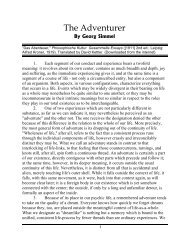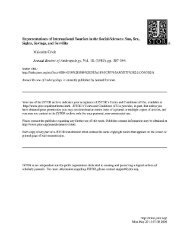The Maya Uay K'ot - OSEA-CITE
The Maya Uay K'ot - OSEA-CITE
The Maya Uay K'ot - OSEA-CITE
You also want an ePaper? Increase the reach of your titles
YUMPU automatically turns print PDFs into web optimized ePapers that Google loves.
Yucatecans familiar with the mayokol's role in protecting plantation property suggest that<br />
the term really derives from two <strong>Maya</strong> morphemes; ma’, a negative particle which<br />
precedes the verb stem (DMC 469), and okol, a verb meaning "to steal" (DMC 597).<br />
4 In Of Wonders and Wise Men, Terry Rugeley points out that the priest and the hacienda<br />
owner were often one and the same, living fat off the labor of <strong>Maya</strong> workers. He also<br />
includes some rather colorful complaints about priestly excess, including one alleging<br />
that Raymundo Pérez, the priest of Mascuspana, forced his parishioners to hunt alligators<br />
that were so ferocious “they will eat a Christian” (2001: 44). While Rugeley views this<br />
complaint as an example of rhetoric rather than historical fact, it points to a tradition of<br />
discussing priests in unflattering ways. For another account of abusive priests in the<br />
peninsula see Irwin Press’s study of Pustunich, Yucatán (1977). <strong>Maya</strong>n folk literature<br />
also contains a healthy share of dumb priest stories. See, for example, “A Story about a<br />
Trickster and a Priest” in An Epoch of Miracles (Burns 1983: 152-7).<br />
5 <strong>The</strong> terms pach and pach’ open up a variety of interpretive possibilities. According to<br />
the Diccionario <strong>Maya</strong> Cordemex, the term pach’ not only refers to an object striking the<br />
ground, but to an object or animal which hangs limply like a piece of wet rope. Since<br />
several versions of the tale conclude with the evil way hanging himself in his prison cell,<br />
this referent is particularly apt. Indeed, death by hanging is considered an act of<br />
redemption in <strong>Maya</strong> mythology. <strong>The</strong> term pach also leads in an interesting, if somewhat<br />
different, direction. In its nominal form it describes a measure of cloth, the spine of an<br />
animal or the plumage of a bird (DMC 615). In its verbal form it means: 1. to appropriate<br />
or take possession, or 2. to augment or multiply. Either of the latter, of course, make<br />
sense if way kot is an anthropomorphic image of gold or token money (DMC 615-616).<br />
6<br />
<strong>The</strong> equation between feces and money has, of course, been noted in other contexts. Not<br />
only does the Thompson motif index have a place for donkeys that defecate ducats<br />
(B103.1.1), but as Alan Dundes notes (2002: 101) this association is “well attested in<br />
contemporary folkspeech: filthy lucre, to be filthy or stinking rich, to be rolling in it, to<br />
have money up the ass, and so forth ... Still other illustrative slang terms are ‘paydirt’ and<br />
‘shitload.’” However, contra Dundes, I see no reason to view money or accumulation as a<br />
sublimated form of infantile pleasures (e.g., the desire to play with one’s feces) or as<br />
evidence of anal-erotic tendencies. I prefer a more direct approach; monetary<br />
accumulation is filthy because it is inherently anti-social and undermines established<br />
forms of reciprocity. In any case, readers who are interested in further examples of<br />
money as feces should refer to Park Redfield’s tale of Don Juan Conejo, a trickster who<br />
sells the same corn to several different animals, and then buries the money in the ground.<br />
Later he decides to dig it up and divide it among his friends, but it has turned to shit so he<br />
plays with it, “throwing it up as if they were balls” (1937: 35).<br />
7 A recent article by John Tofik Karam in the Journal of Latin American Anthropology<br />
(Fall 2004) allows for an interesting comparison between Lebanese immigrants in<br />
Yucatán and the Sirio-Lebanese population of Brazil. Like their counterparts in Yucatán,<br />
Brazilians of Lebanese ancestry got their start as peddlers, selling cheap goods in a cash<br />
poor economy. Like the former, they were also depicted as parasites “who traded goods<br />
but failed to ‘produce’ real wealth” (2004: 321). As Karam points out, Middle Eastern<br />
merchants were even disparaged by leading statesmen like Roquette-Pinto (2004:330):<br />
“... turcos peddle in all parts. <strong>The</strong>y entrench themselves, seeking clients in all corners.<br />
20




